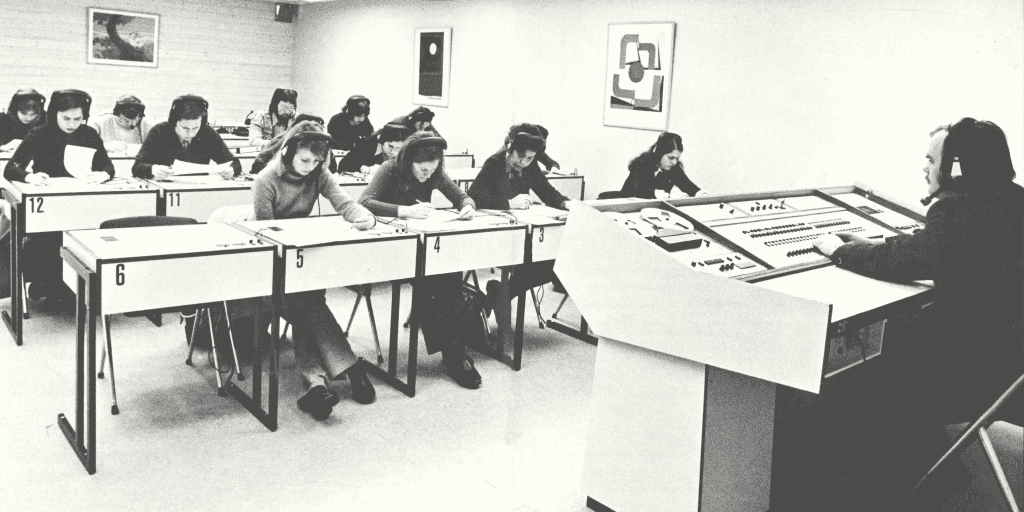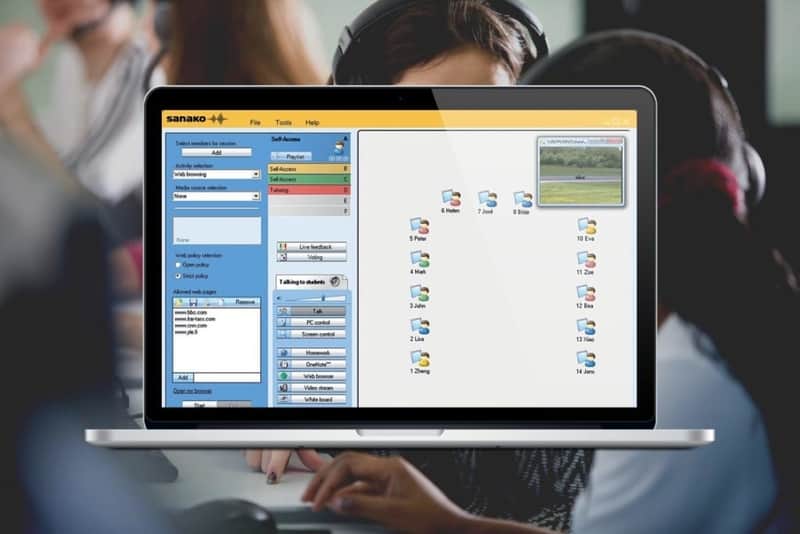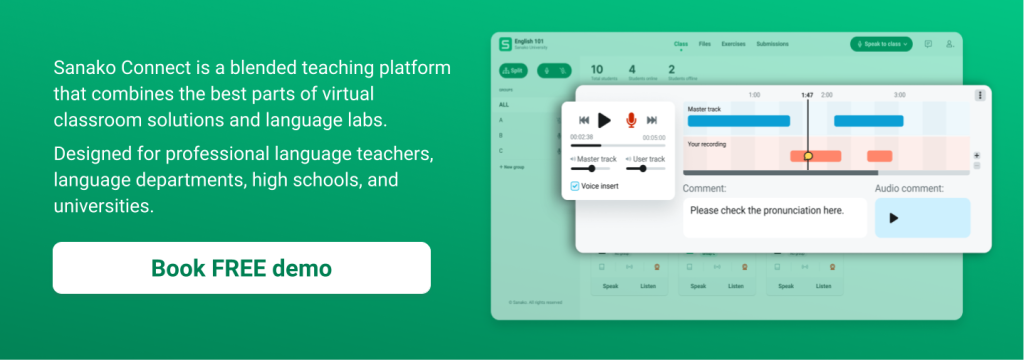Colin Firth and Prince Charles are probably unlikely advocates for the power of modern language labs to support language learning. But eagle-eyed teachers and students will have certainly spotted them learning Portuguese and Welsh whilst appearing in Love Actually and The Crown TV Series. But why are language labs still so popular today, particularly in this age of online language learning? There’s even a vibrant online market in iconic Tandberg language labs and associated equipment for product aficionados. This post explores how modern and digital language laboratories continue to support students and reviews how Sanako’s solutions remain clear international market-leaders.
Why should a school use a language lab?
Most traditional language labs are formatted in a similar fashion. They tend to be permanent fixtures, located in a dedicated room. Each student position has a desktop computer (or laptop) with a headset, whilst the teacher seat has a master control console/panel/computer to direct learning. Educators and learners both access the lab platform via a centralised school-based server or LAN network.
This approach easily enables teachers to direct both synchronous (or “live”) and asynchronous (or “self-study”) activities. The former tend to be most prevalent in primary or secondary school environments, whilst asynchronous activities are most common in both university and/or adult language learning settings.
The following synchronous activities can, for example, be easily and simultaneously delivered by language educators to a group of students using their central control panel or desktop computer.
- Teacher / student-led presentations
- Student conversation (and recording) in pairs or groups
- Monitoring of student audio and student screens
- Live testing (including AP Exam’s speaking activities in the USA)
Language labs can also be flexibly deployed to deliver self-study activities, which learners can complete in their own time in any order. Typically, these are pre-prepared by educators and are then assigned to students to work on as in-class or homework/revision activities.
- Open and simultaneous audio recording
- Free text
- Question and answer
- Multiple choice quizzes
- Fill-in-the-blanks quizzes
As technology has advanced, WiFi and portable devices (e.g. laptops and smartphones) now offer increased flexibility, allowing institutions to roll out portable language lab solutions without a need for a dedicate language learning space/classroom. These enable students to learn at any time, in any location and on any device – such solutions have, of course, been invaluable as educators respond to distance learning challenges posed by Covid-19.
Students’ feedback on the advantages of language labs
In a 2015 paper, Serkan Lokmacıoğlu et al* conducted an extensive survey with Turkish students to understand their perspectives on using language lab environments. Despite some problems identified with sound quality and technology, the results are encouragingly positive.
- 83.9% of the participants agree that it is very helpful to study English in the language labs. Students also think that language labs are beneficial in their language studies.
- Over half of students agree or strongly agree that the language lab is highly beneficial for developing listening skills.
- 82.1% of the students think that language labs make the learning process easier than in a “normal” classroom, whilst nearly 3/4 find more opportunities to practice English in the labs.
- Finally, nearly all students (82.2%) believe that language labs provide a better environment for concentration and 87.5% for comfort.
Perhaps most importantly, language lab environments are highly effective in supporting students to practice their speaking skills. Research from Deutsch Englisch Schülerleistungen International (DESI) found that students in traditional classrooms only had 21 seconds speaking time per lesson but that the use of language labs / software boosted this to 11 minutes per lesson. These technologies are also therefore able to drive greater improvements in learning outcomes.
Language lab technology moves forward
Lokmacıoğlu et al’s research also clearly identified that students are looking for language lab solutions to move with the times and to incorporate the latest technologies. As such, solutions such as Sanako’s Study 1200 are fully technology-enabled digital language centres, encompassing so much more than simple one to one audio and classroom management options.
As we’ve seen in recent months, the move from fixed and/or portable language lab solutions has moved onto the next level with virtual language lab solutions, such as Sanako Connect, becoming increasingly popular. These technologies are functionally identical to traditional language labs except that teachers and students can all access the platform (and its resources) from innumerable, remote locations via a cloud-based server. In so doing, they provide more efficient and impactful ways to learn/teach languages.
If you’d like to find out more about how Sanako’s suite of language labs and online teaching software can help your learners, please contact us now to arrange your free demo!
References:
* GlobELT: An International Conference on Teaching and Learning English as an Additional Language. Language labs: Dying or evolving? Serkan Lokmacıoğlu et al, Turkish Military Academy, Department of Foreign Languages, Ankara, Turkey.


